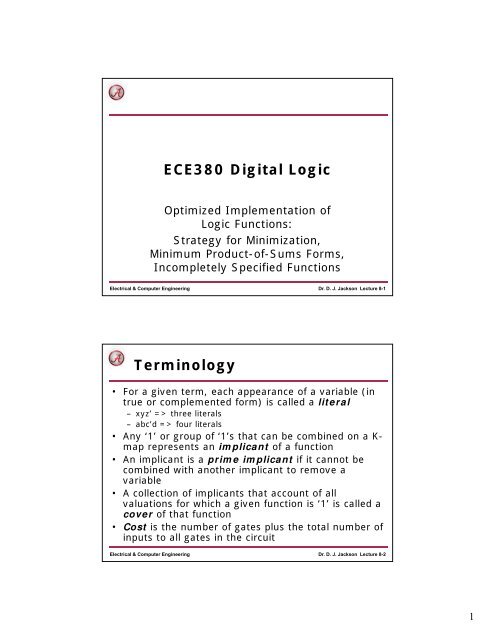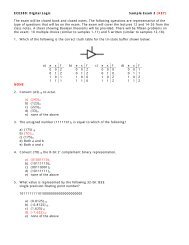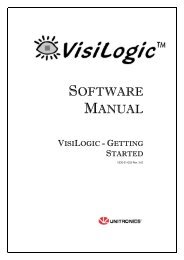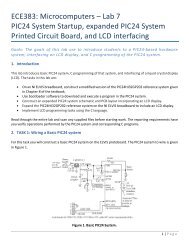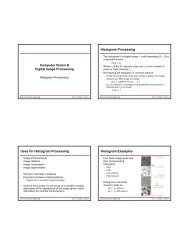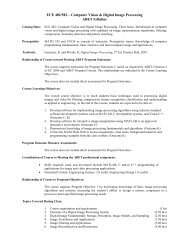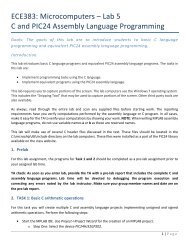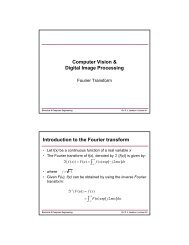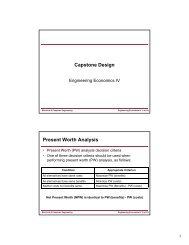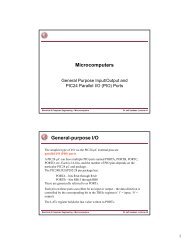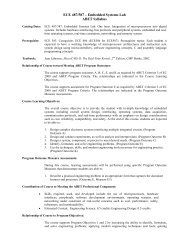ECE380 Digital Logic Terminology
ECE380 Digital Logic Terminology
ECE380 Digital Logic Terminology
Create successful ePaper yourself
Turn your PDF publications into a flip-book with our unique Google optimized e-Paper software.
<strong>ECE380</strong> <strong>Digital</strong> <strong>Logic</strong><br />
Optimized Implementation of<br />
<strong>Logic</strong> Functions:<br />
Strategy for Minimization,<br />
Minimum Product-of-Sums Forms,<br />
Incompletely Specified Functions<br />
Electrical & Computer Engineering<br />
Dr. D. J. Jackson Lecture 8-1<br />
<strong>Terminology</strong><br />
• For a given term, each appearance of a variable (in<br />
true or complemented form) is called a literal<br />
– xyz’ => three literals<br />
– abc’d => four literals<br />
• Any ‘1’ or group of ‘1’s that can be combined on a K-<br />
map represents an implicant of a function<br />
• An implicant is a prime implicant if it cannot be<br />
combined with another implicant to remove a<br />
variable<br />
• A collection of implicants that account of all<br />
valuations for which a given function is ‘1’ is called a<br />
cover of that function<br />
• Cost is the number of gates plus the total number of<br />
inputs to all gates in the circuit<br />
Electrical & Computer Engineering<br />
Dr. D. J. Jackson Lecture 8-2<br />
1
<strong>Terminology</strong> example<br />
ab<br />
cd<br />
00<br />
00 01<br />
1 1<br />
11 10<br />
0 0<br />
f(a,b,c,d)=m(0,1,4,5,7,9,11)<br />
01<br />
11<br />
1<br />
0<br />
1<br />
1<br />
0<br />
0<br />
1<br />
1<br />
Example Implicants: all single ‘1’s,<br />
a’c’, a’b’c’,<br />
a’bd, ab’d<br />
10<br />
0<br />
0<br />
0<br />
0<br />
Prime Implicants: a’c’, a’bd, ab’d, b’c’d<br />
f(a,b,c,d) min : a’c’+a’bd+ab’d<br />
Thus, a minimum SOP form contains only<br />
(but not necessarily all) prime implicants.<br />
Electrical & Computer Engineering<br />
Dr. D. J. Jackson Lecture 8-3<br />
Prime implicants distinctions<br />
• Essential: needed to form a minimum<br />
solution<br />
• Nonessential: not necessarily needed to<br />
form a minimum solution<br />
ab<br />
cd<br />
00<br />
01<br />
11<br />
10<br />
00 01<br />
0<br />
1<br />
1<br />
0<br />
1<br />
1<br />
0<br />
0<br />
11 10<br />
0<br />
0<br />
1<br />
1<br />
0<br />
1<br />
1<br />
0<br />
All prime implicants: b’d, a’bc’, abc<br />
a’c’d, acd<br />
Essential primes: b’d, a’bc’, abc<br />
Nonessential primes: a’c’d, acd<br />
f(a,b,c,d) min : b’d+a’bc’+abc<br />
Minimum contains all essential and possibly some nonessential primes<br />
Electrical & Computer Engineering<br />
Dr. D. J. Jackson Lecture 8-4<br />
2
Prime implicants example<br />
ab<br />
cd<br />
00<br />
00 01<br />
0 0<br />
11 10<br />
0 0<br />
Essential primes: a’c, ac’d<br />
Nonessential primes: a’bd, bc’d<br />
01<br />
0<br />
1<br />
1<br />
1<br />
11<br />
10<br />
1<br />
1<br />
1<br />
1<br />
0<br />
0<br />
0<br />
0<br />
One of these must be<br />
included to form a<br />
minimum solution<br />
f(a,b,c,d) min : a’c+ac’d+<br />
a’bd<br />
bc’d<br />
Electrical & Computer Engineering<br />
Dr. D. J. Jackson Lecture 8-5<br />
Prime implicants example<br />
Identify all prime implicants for the<br />
given truth table. Which are essential<br />
and which are nonessential? What is<br />
a minimum SOP expression for this<br />
function?<br />
ab<br />
cd<br />
00<br />
00 01<br />
0<br />
0<br />
11 10<br />
0<br />
0<br />
01<br />
0<br />
1<br />
1<br />
1<br />
11<br />
0<br />
1<br />
1<br />
0<br />
10<br />
1<br />
1<br />
0<br />
1<br />
Electrical & Computer Engineering<br />
Dr. D. J. Jackson Lecture 8-6<br />
3
Minimization of POS expressions<br />
• POS minimization using K-maps proceeds<br />
exactly as does SOP form except that<br />
groupings of ‘0’s in the K-map are used to<br />
form POS terms.<br />
• K-map can be constructed directly from M<br />
expression for a function<br />
• Place ‘0’s in the K-map for every maxterm in<br />
the M expression<br />
Electrical & Computer Engineering<br />
Dr. D. J. Jackson Lecture 8-7<br />
Minimization of POS example<br />
f(a,b,c)=(a+b’+c’)(a’+b+c’)(a’+b’+c)(a’+b’+c’)<br />
f(a,b,c)=M(3,5,6,7)<br />
ab<br />
c<br />
00<br />
0 1<br />
01<br />
1<br />
11 10<br />
0<br />
1<br />
1<br />
1<br />
0<br />
0<br />
0<br />
f=(a’+b’)(b’+c’)(a’+c’)<br />
Electrical & Computer Engineering<br />
Dr. D. J. Jackson Lecture 8-8<br />
4
Minimization of POS example<br />
f(a,b,c,d)=M(0,1,4,8,10-12,14,15)<br />
ab<br />
cd<br />
00 01<br />
11 10<br />
(c+d)<br />
(a+b+c)<br />
00<br />
0<br />
0<br />
0<br />
0<br />
01<br />
0<br />
1<br />
1<br />
1<br />
11<br />
1<br />
1<br />
0<br />
0<br />
(a’+c’)<br />
10<br />
1<br />
1<br />
0<br />
0<br />
f(a,b,c,d) min = (a+b+c)(a’+c’)(c+d)<br />
Electrical & Computer Engineering<br />
Dr. D. J. Jackson Lecture 8-9<br />
K-map groupings example<br />
• Draw the K-map and give the minimized POS<br />
logic expression for the following.<br />
– f(a,b,c)=M(0,2,3,5-7)<br />
• Show the groupings made in the K-map<br />
Electrical & Computer Engineering<br />
Dr. D. J. Jackson Lecture 8-10<br />
5
Incompletely specified functions<br />
• In digital systems it often happens that some<br />
input conditions (i.e. some input valuations)<br />
can never happen<br />
• An input combination that can never happen<br />
is referred to as a don’t care condition<br />
• As a circuit is designed, a don’t care<br />
condition can be ignored (i.e. the output for<br />
that condition can be treated as 0 or 1 in the<br />
truth table)<br />
• A function that has don’t care condition(s) is<br />
said to be incompletely specified<br />
Electrical & Computer Engineering<br />
Dr. D. J. Jackson Lecture 8-11<br />
Example function with don’t cares<br />
x y z f<br />
0 0 0 1<br />
0 0 1 1<br />
0 1 0 d<br />
0 1 1 d<br />
1 0 0 1<br />
1 0 1 1<br />
1 1 0 0<br />
1 1 1 0<br />
Assume for a three variable function f(x,y,z)<br />
that the input combination xy=01 never occurs,<br />
otherwise the function is m(0,1,4,5)<br />
f(x,y,z)= m(0,1,4,5)+D(2,3)<br />
Or<br />
f(x,y,z)= M(6,7) · D(2,3)<br />
Electrical & Computer Engineering<br />
Dr. D. J. Jackson Lecture 8-12<br />
6
Example function with don’t cares<br />
f(x,y,z)= m(0,1,4,5)+D(2,3)<br />
f(x,y,z)= M(6,7) · D(2,3)<br />
xy<br />
z<br />
00<br />
0 1<br />
01<br />
d<br />
11 10<br />
0<br />
1<br />
xy<br />
z<br />
00<br />
0 1<br />
01<br />
d<br />
11 10<br />
0<br />
1<br />
1<br />
1<br />
d<br />
0<br />
1<br />
1<br />
1<br />
d<br />
0<br />
1<br />
f(x,y,z)= y’ f(x,y,z)= y’<br />
Electrical & Computer Engineering<br />
Dr. D. J. Jackson Lecture 8-13<br />
Minimum SOP form<br />
1. Choose a minterm (a ‘1’ in the K-map) which is not<br />
yet covered (don’t consider d’s).<br />
2. Find all adjacent ‘1’s and ‘d’s (check the n adjacent<br />
cells for an n-variable K-map).<br />
3. If a single term (i.e. a single looping) covers the ‘1’<br />
and all adjacent ‘1’s and ‘d’s then the looping forms<br />
an essential prime implicant. Loop the essential<br />
prime.<br />
4. Repeat steps 1-3 until all essential prime implicants<br />
are located.<br />
5. Find a minimum set of nonessential prime<br />
implicants to cover (loop) the remaining ‘1’s. If<br />
more than 1 set is possible, choose the set with the<br />
minimum number of literals (the largest grouping).<br />
Electrical & Computer Engineering<br />
Dr. D. J. Jackson Lecture 8-14<br />
7
Minimum POS form<br />
1. Choose a maxterm (a ‘0’ in the K-map) which is not<br />
yet covered (don’t consider d’s).<br />
2. Find all adjacent ‘0’s and ‘d’s (check the n adjacent<br />
cells for an n-variable K-map).<br />
3. If a single term (i.e. a single looping) covers the ‘0’<br />
and all adjacent ‘0’s and ‘d’s then the looping forms<br />
an essential prime implicant. Loop the essential<br />
prime.<br />
4. Repeat steps 1-3 until all essential prime implicants<br />
are located.<br />
5. Find a minimum set of nonessential prime<br />
implicants to cover (loop) the remaining ‘0’s. If<br />
more than 1 set is possible, choose the set with the<br />
minimum number of literals (the largest grouping).<br />
Electrical & Computer Engineering<br />
Dr. D. J. Jackson Lecture 8-15<br />
8


